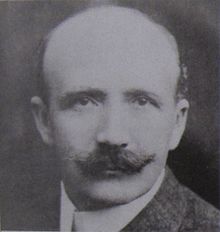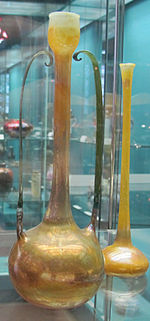Josef Emil Schneckendorf
Josef Emil Schneckendorf (born December 29, 1865 in Kronstadt , Transylvania , † July 11, 1949 in Munich ) was a German sculptor and glass artist of Art Nouveau . From 1906 to 1911 he was a member of the Darmstadt artists' colony and from 1907 to 1911 ran the Grand Ducal precious glass manufacture in Darmstadt .
Life
Josef Emil Schneckendorf trained as a sculptor in Budapest , Bucharest and Vienna . From 1890 he worked in Munich. In 1892 he enrolled at the Munich Academy to study sculpture . However, under the influence of the artistic reform movement that was forming in Munich around the United Workshops for Art in Crafts , he then dealt with the production of jewelry made of glass and metal. He taught himself the techniques necessary for the production of art glass as an autodidact . From 1898 he dedicated himself entirely to the manufacture of precious glass. His interest was initially directed towards the freely formed glass "blown in front of the lamp", to which he melted coloring metal oxides in order to create iridescent effects.
From 1901 Schneckendorf was continuously represented at exhibitions in Munich and Dresden , but also at international exhibitions such as in Turin in 1902 and in St. Louis in 1904 , where his carafes, vases and stemmed glasses were repeatedly awarded prizes . At that time people were enthusiastic about the metal reflex effects of ceramics and precious glass. The relics of the ancient glass industry discovered during excavations, the iridescent patina of which can be traced back to chemical reactions with the metal salts contained in the soil, contributed to the exploration of the shimmering play of colors.
Louis Comfort Tiffany was the first to take up these suggestions at the end of the 19th century, thus triggering the boom in iridescent glass. Schneckendorf was particularly fascinated by the dematerialization effect that results from the flickering reflection of light on the metallic surfaces. He then made these metal reflections and their artistic expression possibilities an essential element of his glass finishing.
In 1906 he was appointed by Grand Duke Ernst Ludwig to the artists' colony in Darmstadt, where he also took over the management of the Grand Ducal precious glass manufacture in 1907 . Due to the permanent deficits that the Grand Duke financed from his private fortune, he separated from the manufacture in 1909. Schneckendorf continued to run the facility as the sole owner and tried out ways to make glass processing cheaper, but then stopped production in autumn 1911. He left Darmstadt and moved back to Munich, where he gradually said goodbye to glass art.
Works
The Grand Ducal Noble Glass Manufactory only produced small quantities. Schneckendorf himself, with a helper, created his luxury glasses in elaborate work processes, the high price of which was only afforded by a small group of wealthy connoisseurs and lovers.
The work of the Art Nouveau artist, which is hardly known to a wider public today, only includes a few preserved, very exclusive precious glass works. A note on a business card shows that Schneckendorf produced 615 fine glasses in the first two years of the manufacture, 74 of which he rejected due to breakage or blemishes. It is assumed that afterwards no more precious glasses were made and that many were lost during the war, so that those still preserved today are a real rarity.
From May 21 to August 28, 2005, the Museum Künstlerkolonie Darmstadt presented around 85 precious decorative glasses from museum and private collections, some of which have never been shown to the public.
literature
- Herbert Paulus : Josef Emil Schneckendorf 1865 to 1949. His life and its importance for the creation of precious glass in Art Nouveau . Mayer, Erlangen 1993.
- Renate Ulmer (Ed.): Josef Emil Schneckendorf and the Grand Ducal Noble Glass Manufactory - Art Nouveau glass from Darmstadt . Museum Künstlerkolonie Darmstadt 2005, Arnoldsche Verlagsanstalt, Stuttgart 2005, ISBN 3-89790-227-3 .
Web links
- Literature by and about Josef Emil Schneckendorf in the catalog of the German National Library
- Iridescent Art Nouveau glass - Josef Emil Schneckendorf and the Grand Ducal precious glass manufacture
- United workshops for arts and crafts in designlexikon.net
| personal data | |
|---|---|
| SURNAME | Schneckendorf, Josef Emil |
| BRIEF DESCRIPTION | German artist |
| DATE OF BIRTH | December 29, 1865 |
| PLACE OF BIRTH | Kronstadt , Transylvania |
| DATE OF DEATH | July 11, 1949 |
| Place of death | Munich |

